Table of Contents
Introduction
Computing Power Statistics: Computing capability, which signifies a computer system’s capacity to swiftly and effectively carry out tasks.
Which hinges on hardware elements like the CPU, GPU, memory, and storage devices. Criteria like clock speed, quantity of cores, and FLOPS are gauged by this.
Factors that impact computing capability include Moore’s Law, cooling solutions, overclocking, energy efficiency, and thermal design power.
Elevated computing power has applications in areas such as scientific exploration, artificial intelligence, gaming, cryptocurrency mining, and data analysis.
Upcoming trends encompass quantum computing, neuromorphic computing, edge computing, specialized hardware for AI, and energy-conscious computing. Challenges encompass physical limitations, energy consumption, safety, and accessibility concerns.
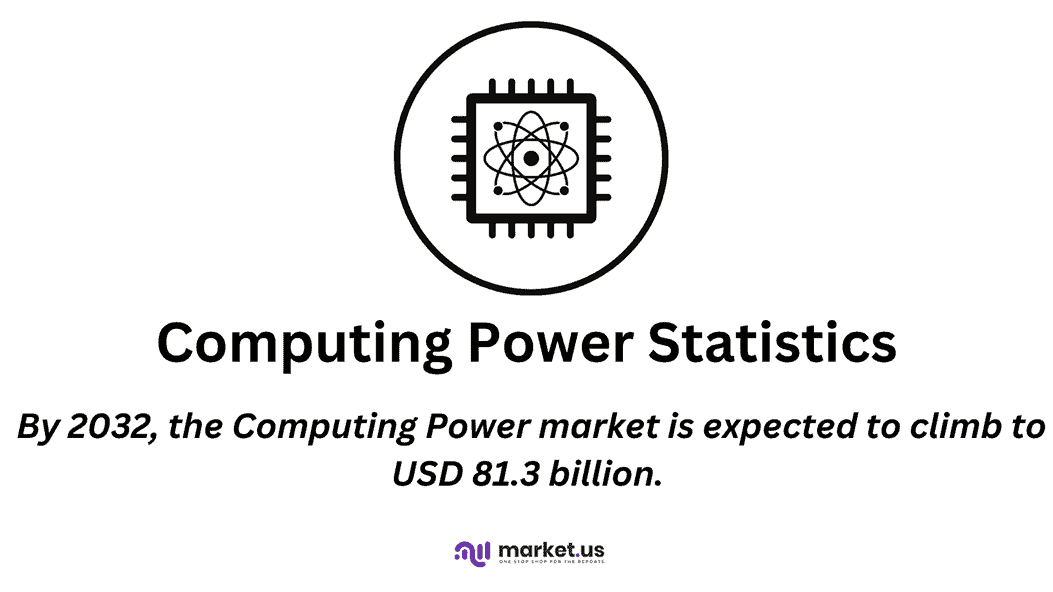
Editor’s Choice
- Over the next decade, the computing power market is poised for significant growth at a CAGR of 6.8%.
- In 2022, the market revenue stands at 42.8 billion USD. This figure is expected to steadily rise to 81.3 billion in 2032.
- Server revenue is expected to rise from USD 15.1 billion in 2022 to USD 28.6 billion in 2032. While services revenue is forecasted to increase from USD 13.8 billion to USD 26.2 billion during the same period.
- The global computing power market exhibits a significant distribution of deployment modes. With on-premise solutions dominating the landscape with a substantial market share of 65%.
- Windows PCs usually employ the 32-bit x86 architecture, Apple utilizes PowerPC chips. Which can be 64 or 128-bit, providing them with a performance edge despite lower clock speeds.
- Most computers today use standard PC100 RAM, which operates at 100MHz, suitable for most applications.
- Nowadays, most hard drives spin at 7,200 RPMs, while older models and laptops typically spin at 5,200 RPMs.
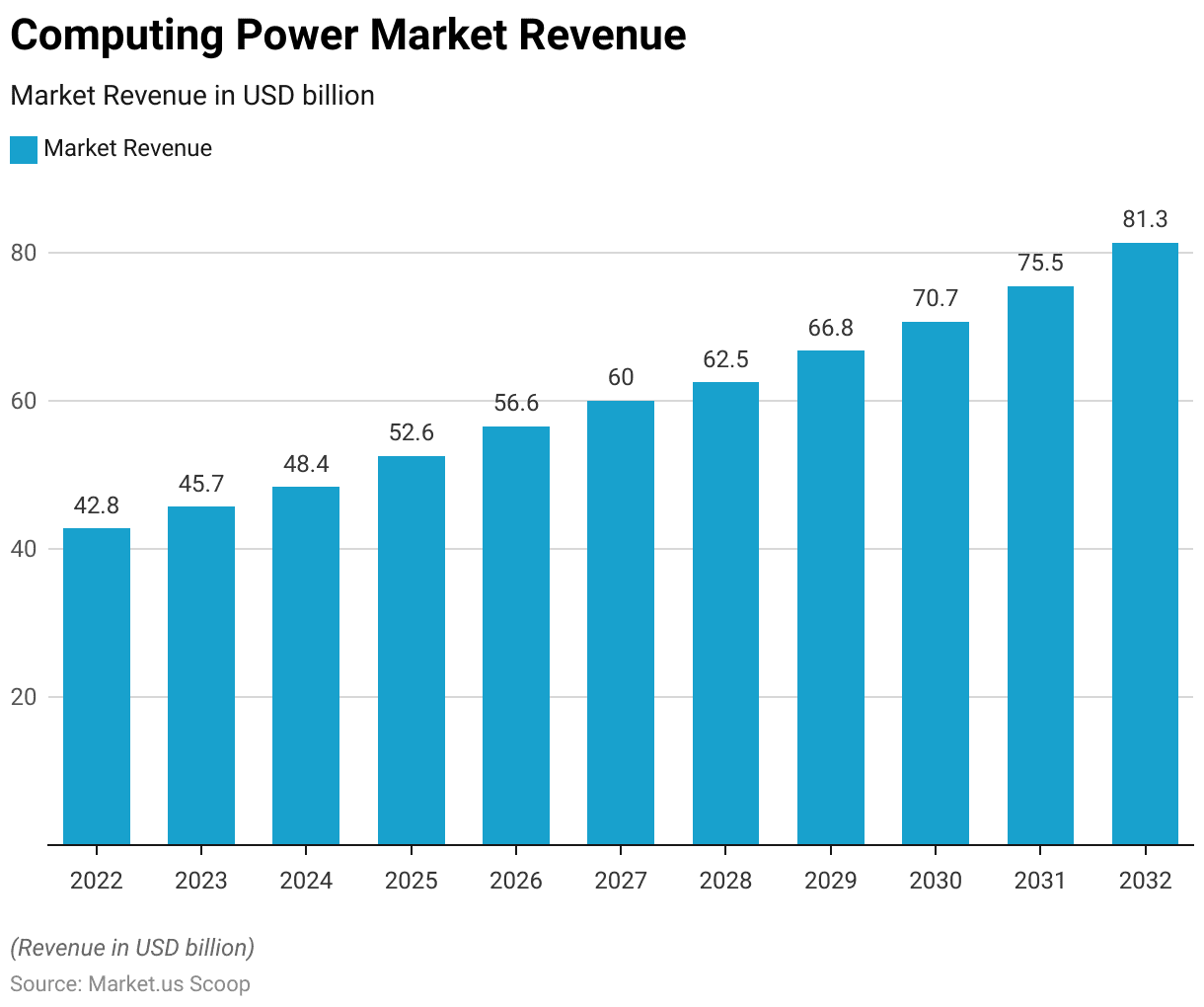
Computing Power Market Statistics
Global Computing Power Market Size Statistics
- Over the next decade, the computing power market is poised for significant growth at a CAGR of 6.8%, as indicated by the projected revenues in billions of USD.
- In 2022, the market revenue stands at 42.8 billion USD. In the coming years, this figure is expected to steadily rise
- By 2023, it is estimated to reach 45.7 billion USD. Followed by 48.4 billion USD in 2024 and 52.6 billion USD in 2025.
- This growth trajectory continues with revenues of 56.6 billion USD in 2026 and 60.0 billion USD in 2027.
- As we move towards the end of the decade, the market is predicted to see even more substantial gains. Reaching 62.5 billion USD in 2028 and 66.8 billion USD in 2029.
- By 2030, the computing power market is projected to generate 70.7 billion USD in revenue. This upward trend continues into 2031, with an estimated revenue of 75.5 billion USD.
- Finally, in 2032, the market is expected to reach an impressive 81.3 billion USD in revenue.
- This consistent growth signifies the increasing demand and importance of computing power in our evolving digital landscape. With advancements in technology and innovation driving the market’s expansion.
(Source: Market.us)
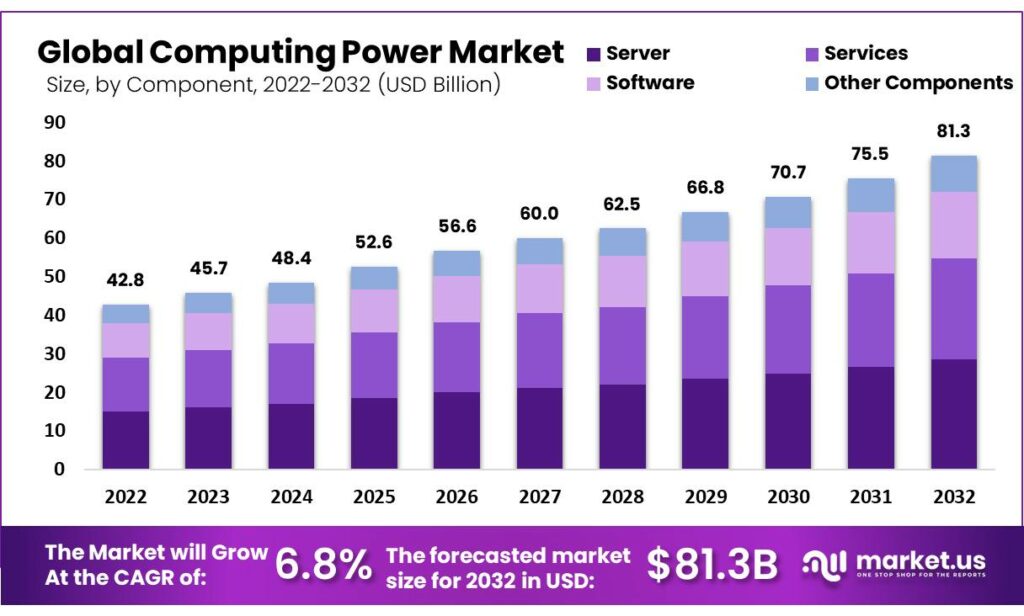
Global Computing Power Market Size – By Component Statistics
- The global computing power market is expected to experience steady growth over the next decade.
- In 2022, the total market revenue reached USD 42.8 billion, with servers contributing USD 15.1 billion. Services generated USD 13.8 billion, software accounted for USD 9.0 billion, and other components contributed USD 4.9 billion to the market.
- Looking ahead, the market is projected to expand. Reaching USD 45.7 billion in 2023 and continuing to grow to USD 81.3 billion by 2032.
- This growth will be driven by increasing demand for computing power across various industries.
- Server revenue is expected to rise from USD 15.1 billion in 2022 to USD 28.6 billion in 2032.
- While services revenue is forecasted to increase from USD 13.8 billion to USD 26.2 billion during the same period.
- Software revenue will also see significant growth, reaching USD 17.2 billion in 2032, and other components revenue is expected to reach USD 9.4 billion.
- These projections reflect the ongoing importance of computing power in our increasingly digital and interconnected world. Businesses and organizations rely on it for various applications and services.
(Source: Market.us)
Take advantage of our unbeatable offer - buy now!

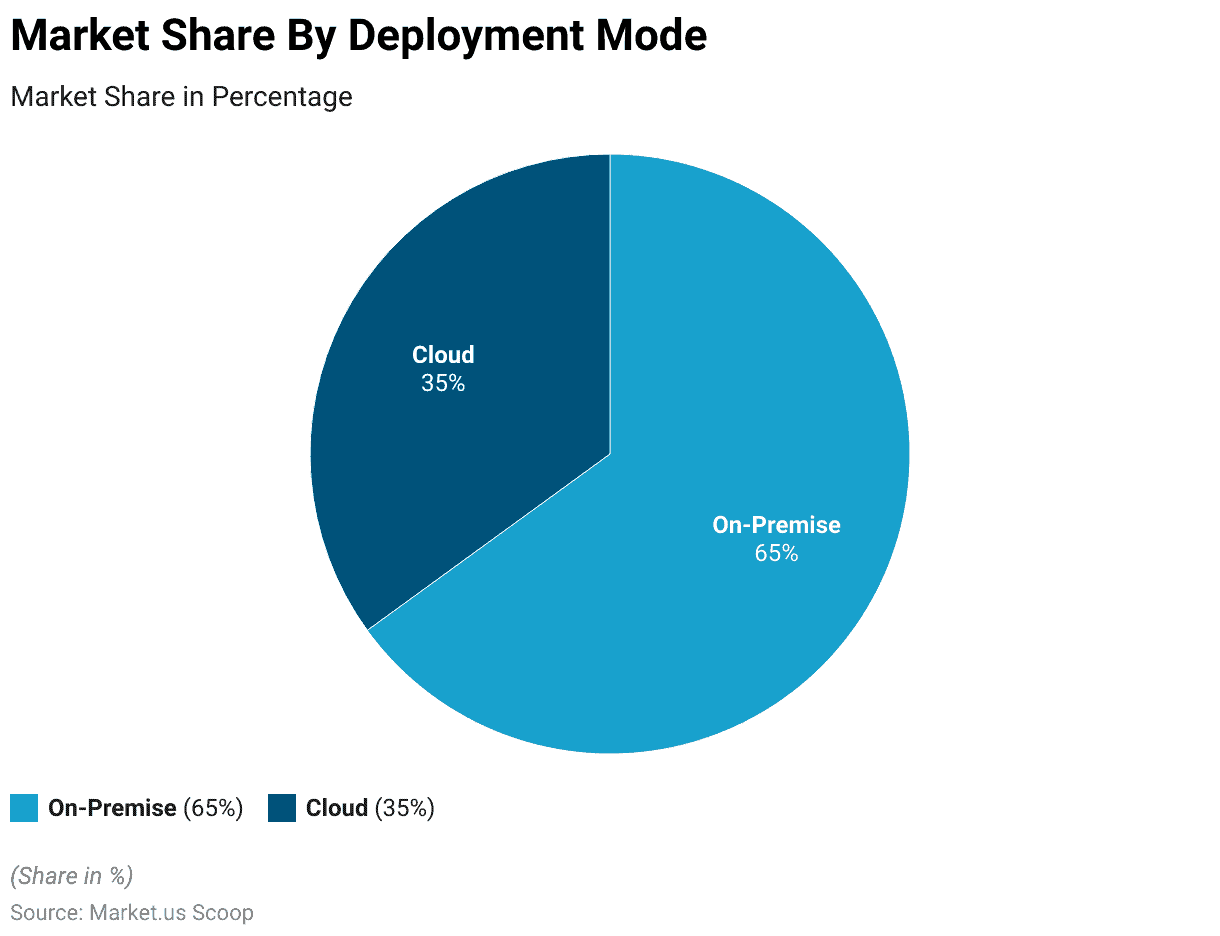
Computing Power Market Share – By Deployment Mode Statistics
- The global computing power market exhibits a significant distribution of deployment modes. With on-premise solutions dominating the landscape with a substantial market share of 65%.
- On the other hand, cloud-based solutions account for the remaining 35% of the market share. This division underscores the diverse preferences and requirements of businesses and organizations when it comes to their computing power infrastructure.
- On-premise solutions continue to be favored by many enterprises that prioritize having full control over their hardware and data security.
- In contrast, the adoption of cloud-based solutions is on the rise, driven by factors such as scalability, flexibility, and cost-efficiency.
- This balance between on-premise and cloud-based deployments reflects the dynamic nature of the computing power market. Where businesses are increasingly leveraging a mix of these deployment modes to meet their specific needs and objectives in an ever-evolving digital landscape.
(Source: Market.us)
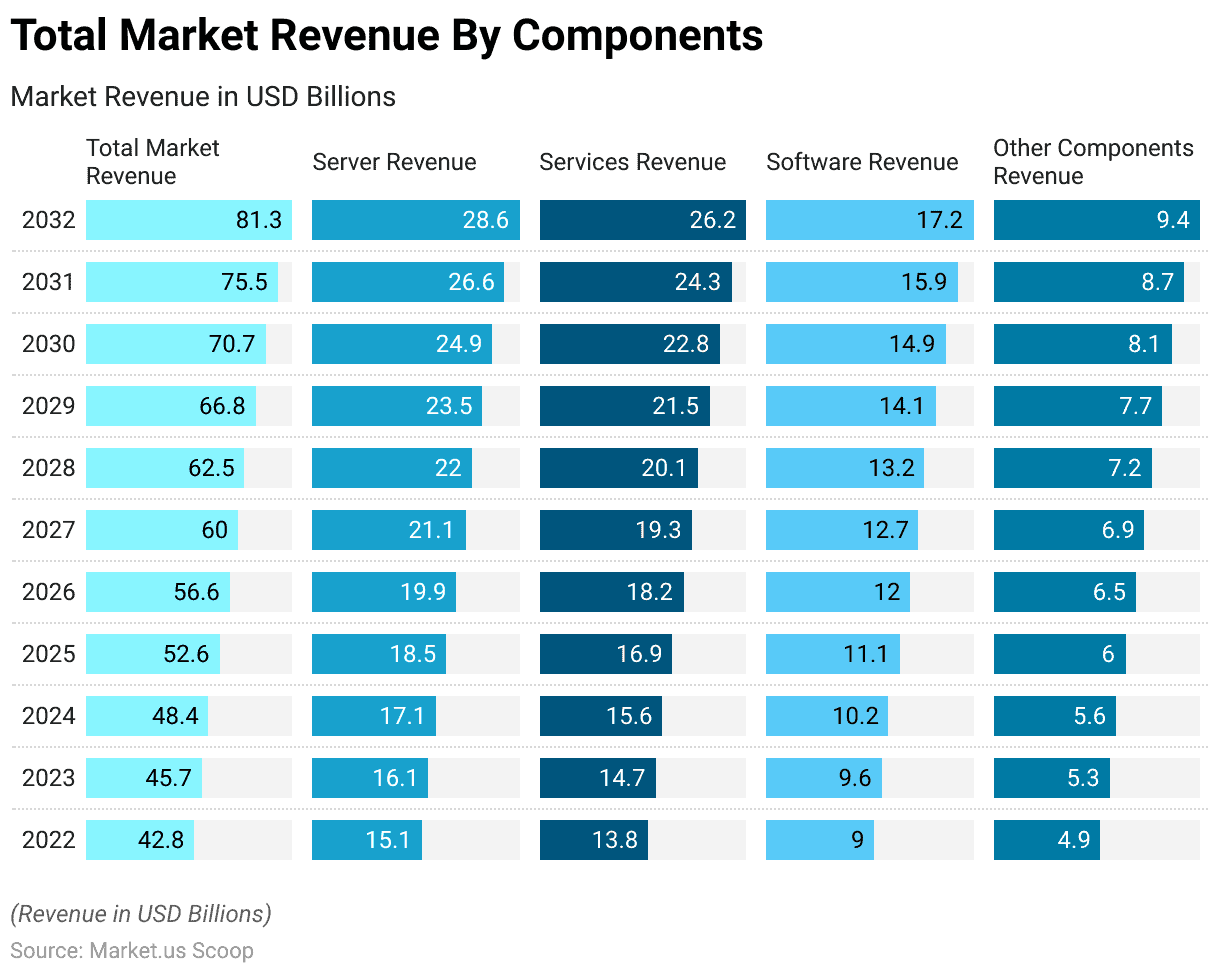
Historical Trends in Computing Power Statistics
- In December 1945, ENIAC was the first electronic general-purpose computer. They conducted hydrogen bomb calculations at the University of Pennsylvania’s Moore School of Electrical Engineering under a U.S. Army contract.
- By March 1951, the U.S. Census Bureau purchased the Univac computer from Eckert-Mauchly, marking the start of the U.S. commercial computer market. Univac’s advantage was its use of tape instead of labor-intensive punch cards.
- By 1954, 20 Univac computers were sold at a cost of about one million dollars each.
- In 1961, Ole-Johan Dahl and Kristen Nygaard began developing SIMULA, a language for computer simulations, at the Norwegian Computer Center.
- In April 1964, IBM introduced the System 360 computer family, streamlining upgrades with a shared instruction set.
- In 1971, Bob Thomas at BBN created the initial computer virus, called Creeper. Which replicated itself on ARPANET-linked computers and displayed the message “I’m the creeper, catch me if you can!”
- In 1981, Apollo Computer introduced the first graphics workstation using the Motorola 68000 microprocessor. Later joined by competitors Sun Microsystems and Silicon Graphics.
- In December 1987, Toshiba unveiled NAND Flash Memory at the IEEE 1987 International Electron Devices Meeting. This memory could retain data without power, could be electrically erased and reprogrammed, and eventually replaced hard disks in most personal computers.
- In May 1995, Sun launched Java, a programming language aimed at enabling cross-platform compatibility. It gained popularity when Netscape used it for web page animation and interactivity.
- In October 2012, a convolutional neural network created by University of Toronto researchers achieved a remarkable 16% error rate in the ImageNet Large Scale Visual Recognition Challenge, improving upon the previous year’s 25% rate.
- Finally, in July 2020, OpenAI introduced GPT-3, which, powered by 175 billion machine learning parameters, generates text that resembles human language.
(Source: Forbes)
Factors Affecting Computing Power Statistics
Processor Speed
- Processor speed, often referred to as clock speed, is sometimes overstated as the primary driver of a computer’s performance. While it does matter for tasks like video encoding and complex calculations. The average user rarely pushes their CPU to its limits.
- During everyday activities like typing, email, or web browsing. The CPU typically runs at just 1 or 2 percent of its maximum speed. The CPU encounters significant demands primarily during startup, often hampered by hard drive speed.
- Megahertz (MHz) or Gigahertz (GHz) indicates how rapidly the CPU toggles between 1 and 0, influencing its processing power when all else is equal.
- Higher MHz chips consume more power and generate more heat. Level 1 (L1) and Level 2 (L2) cache are swift on-chip memory used to briefly store data before and after processing.
- SRAM, specific to processors, is costly; nowadays, most chips feature 128KB of L1 cache and 256-512KB of L2 cache.
- While Windows PCs usually employ the 32-bit x86 architecture, Apple utilizes PowerPC chips. Which can be 64 or 128-bit, providing them with a performance edge despite lower clock speeds.
- Intel and AMD are currently developing 64-bit x86 chips, but higher-bit architecture necessitates software adjustments, resulting in compatibility issues between platforms like Mac and PC.
(Source: Lehigh Edu)
System RAM Speed and Size
- The quantity and speed of your computer’s RAM have a significant impact on its performance. If you attempt to run Windows XP with just 64 MB of RAM, it’s likely to struggle or even fail.
- When the available RAM is fully utilized, the computer must resort to using the slower hard drive to cache data. This constant back-and-forth data transfer between RAM and virtual memory (hard drive) considerably slows down the computer, especially when loading applications or files.
- There are two types of RAM, primarily dynamic RAM, which is more common. Dynamic RAM requires frequent refreshing thousands of times per second.
- On the other hand, static RAM doesn’t need refreshing, making it faster but also more expensive. Both types of RAM are volatile, meaning they lose their data when the power is turned off.
- Additionally, the RAM’s speed can be influential. Most computers today use standard PC100 RAM, which operates at 100MHz, suitable for most applications.
- However, gamers and high-end machines often opt for DDR (double data rate) RAM, which is newer and faster at 266MHz, although not all computers are compatible with DDR RAM.
(Source: Lehigh Edu)
Disk Speed and Size (RPMs and Gigabytes)
- The speed of your computer’s hard disk is the most significant factor affecting its performance.
- The hard drive’s ability to quickly locate data (average seek time), read, write, and transfer data has a substantial impact on how your computer operates.
- Nowadays, most hard drives spin at 7,200 RPMs, while older models and laptops typically spin at 5,200 RPMs, which is one reason why laptops may seem slower compared to desktop computers.
- The hard drive’s capacity has a relatively minor role in computer performance.
- As long as you have enough free space for virtual memory and maintain proper disk defragmentation, your computer will perform well regardless of its size.
(Source: Lehigh Edu)
Video Card
- In a typical desktop computer, you’ll find a mid-range video card with 32 to 64 megabytes of video memory, while an average laptop usually has a basic onboard graphics chip with 16 megabytes of memory.
- When your computer displays an image on the screen, it requires a rendering process. If the computer relies on software for this task, it tends to be slower and can adversely affect overall performance.
- Additionally, the displayed images may lack crispness and smoothness, especially in the case of video playback. Even a modest video card can substantially enhance computer performance by offloading the demanding task of rendering images from the CPU to the graphics card.
- If you work with large image files, engage in video editing, or play graphics-intensive games, a higher-end video card becomes essential.
- Video cards come equipped with their dedicated memory known as Video RAM. The amount of Video RAM a computer has directly influences how many textures and images the card can store at once.
- High-end desktop graphics cards can boast up to 64 megabytes of Video RAM, while laptops typically offer a more modest 8 or 16 megabytes of Video RAM.
(Source: Lehigh Edu)
Temperature
- The most common threat to your processor is overheating, which occurs as the CPU takes on more tasks, causing it to heat up.
- High temperatures can harm its performance and potentially shorten its lifespan.
- To prevent overheating, modern processors are designed to operate safely at temperatures up to 176 degrees Fahrenheit (80 degrees Celsius), and some newer Intel and AMD CPUs can handle even higher temperatures, up to 194F/90C.
- If your computer gets excessively hot, the motherboard’s temperature sensor will intervene by slowing down or shutting off the CPU to protect it.
- To ensure your processor stays within safe limits, regularly monitor its temperature. If it consistently exceeds 158 degrees Fahrenheit (70 degrees Celsius), consider investing in a more efficient cooler or a well-ventilated computer case.
(Source: makeuseof.com)
Computing Power Challenges and Statistics
- The era of digitalization is witnessing an unprecedented surge in applications, connections, devices, users, and the volume of generated data. This surge demands vast computational capabilities.
- For instance, the computing power needed for artificial intelligence is doubling every 100 days and is projected to increase by over a million times in the next 5 years.
- As Moore’s law slows down, keeping pace with such rapid growth in computational demands becomes a challenge.
- Additionally, effectively harnessing various specific computing resources is crucial for handling substantial tasks in an intelligent society. Furthermore, traditional hardware models do not align well with intelligent algorithms, limiting software development possibilities.
(Source: Intelligent Computing- A Partner Science Journal)
Recent Developments
Acquisitions and Mergers:
- Nvidia acquires Arm Holdings: In 2024, Nvidia completed its $40 billion acquisition of Arm Holdings. This strategic move aims to combine Nvidia’s GPU technology with Arm’s energy-efficient CPU architectures, potentially revolutionizing computing power in various devices.
- AMD acquires Xilinx: AMD finalized its $35 billion acquisition of Xilinx in late 2023. This merger is expected to enhance AMD’s computing capabilities by integrating Xilinx’s FPGA technology, which is used for adaptive and high-performance computing.
New Product Launches:
- Intel’s Sapphire Rapids: In early 2024, Intel launched its Sapphire Rapids processors, featuring advanced AI acceleration, enhanced security features, and support for DDR5 memory, aiming to boost performance in data centers and high-performance computing (HPC) environments.
- Nvidia’s H100 Tensor Core GPU: Nvidia introduced the H100 Tensor Core GPU in 2023, designed to deliver unprecedented performance for AI, data analytics, and scientific computing workloads, with significant improvements in processing power and efficiency.
Funding:
- Graphcore secures $250 million: In 2023, Graphcore, a company specializing in AI and machine learning accelerators, raised $250 million to expand its IPU (Intelligence Processing Unit) technology and enhance its computing power offerings.
- SambaNova Systems raises $500 million: SambaNova Systems, an AI hardware and software company, secured $500 million in funding in early 2024 to scale its next-generation computing platforms and accelerate AI research and development.
Technological Advancements:
- Quantum Computing Progress: Significant advancements in quantum computing have been made, with companies like IBM and Google demonstrating quantum supremacy, where quantum computers can solve problems beyond the reach of classical computers.
- AI and Machine Learning Integration: The integration of AI and machine learning into computing platforms is enhancing processing capabilities, enabling more efficient data processing, predictive analytics, and complex simulations.
Market Dynamics:
- Growth in HPC Market: The high-performance computing (HPC) market is projected to grow at a CAGR of 7.8% from 2023 to 2028, driven by increasing demand in sectors such as scientific research, financial modeling, and climate simulations.
- Edge Computing Expansion: Edge computing is rapidly growing, with more devices processing data locally rather than in centralized data centers, reducing latency and bandwidth usage. The edge computing market is expected to reach $61 billion by 2028.
Regulatory and Strategic Developments:
- US Government’s Investment in Supercomputing: The US government announced a $1 billion investment in 2023 to develop the next generation of supercomputers, aiming to maintain leadership in computational capabilities for scientific and military applications.
- EU’s Digital Strategy: The European Union’s Digital Strategy includes significant investments in HPC and AI, with plans to build several exascale supercomputers to support scientific research and industrial innovation.
Conclusion
Computing Power Statistics – In summary, computing power is a vital element in the realm of modern technology, influencing a wide array of applications and industries.
It hinges on hardware components such as CPUs, GPUs, memory, and storage drives, with key metrics including clock speed, core count, and FLOPS.
Various factors, including Moore’s Law, cooling methods, power efficiency, and overclocking, exert their influence on computing power.
Its significance is evident across scientific research, artificial intelligence, gaming, cryptocurrency mining, data analysis, and more.
The future holds promising trends like quantum computing, neuromorphic computing, AI hardware accelerators, and energy-efficient computing. Yet, challenges related to physical limits, power consumption, security, and accessibility persist.
As technology advances, computing power continues to shape our digital landscape, offering vast potential for innovation and transformation.
FAQs
Computing power refers to the ability of a computer or a computer system to perform tasks and calculations quickly and efficiently. It is often measured in terms of processing speed, memory capacity, and the ability to handle complex calculations.
Computing power is commonly measured in terms of FLOPS (Floating Point Operations Per Second) for processing speed and in gigabytes (GB) or terabytes (TB) for memory capacity. Higher FLOPS and memory capacity indicate greater computing power.
Computing power is essential for various tasks, including running software applications, performing complex simulations, processing large datasets, and running artificial intelligence and machine learning algorithms. It determines how quickly and efficiently a computer can perform these tasks.
Computing power has evolved significantly over the years, driven by advancements in technology. Early computers like the ENIAC had very limited computing power compared to modern supercomputers and even consumer-grade PCs. Moore’s Law, which states that the number of transistors on a microchip doubles approximately every two years, has been a driving force behind this evolution.
High-computing-power applications include weather forecasting, climate modeling, genetic sequencing, financial modeling, 3D rendering, scientific simulations, and deep learning for artificial intelligence.
Discuss your needs with our analyst
Please share your requirements with more details so our analyst can check if they can solve your problem(s)



